Matthew Goodman is a narrative historian. In his latest book, Eighty Days: Nellie Bly and Elizabeth Bisland’s History-Making Race Around the World, he takes readers into the late 19th century to follow two remarkable female journalists as they race against time—and each other—to complete the fastest journey around the globe ever undertaken. Along the way they see the world in new and different ways, and we get to glimpse what life, colonialism, and the dawning of a newly globalizing but still highly stratified world. He was kind of enough to sit down with me to discuss this superb book.
I’d like to thank you for taking the time to discuss your new book with me. It’s a fantastic read. There’s an immediacy to it that I really appreciated. So some basics. What led you to this project?
I’m very interested in narrative history, which is really the kind of writing I see myself doing—telling a true story, a historical story, and using some of the devices that are usually associated with fiction. I like the fact that it’s possible for a reader to pick up the book and flip to any given page and perhaps not even know if they were reading a history book or a novel. So I was looking around, I had done a book like that before and I was looking around for another topic to do, and I sort of knew who Nelly Bly was, but I wasn’t exactly sure who she was. I knew she was a journalist. I live in Brooklyn, in New York, and there used to be a Nellie Bly amusement park in New York, so I know her as the namesake of this amusement park. But I didn’t know much else about her.
I saw a reference to her and I investigated it. I knew I wanted to write about a female main character. It turned out that she was indeed a journalist, but not just any journalist—this really amazing journalist. A female journalist unlike any that New York had ever seen before. This was a time when most women were relegated to writing for the Women’s Page, writing about recipes and gossip and shopping and so forth. Nellie Bly was an undercover investigative reporter for the most widely read newspaper in New York who was willing to get herself committed to an insane asylum, to expose the conditions in the Blackwell Island Insane Asylum. It was really courageous, she didn’t know if she was going to get back out. It took all of Pulitzer’s doing to get her back out. So I was thrilled to discover her.
And then I discovered that in the fall of 1889 she undertook her most audacious adventure yet, which was to try to go around the world faster than anybody had ever done it before, to try to beat in real life the fictional mark of 80 days that Jules Verne had set. I just immediately thought “That’s the book!” I’m thinking Nellie Bly in Hong Kong! Nellie Bly on the Suez Canal! Then I discovered that Nellie Bly wasn’t only racing against the calendar or against a fictional character but that in fact there was this real life, rival female journalist who was racing in the other direction to beat Nellie Bly! I was just captivated by that, the idea of these two young female journalists racing each other around the world, one going east, one going west.

It’s a fascinating story. The way you describe Nellie Bly is very much how the headlines of the day describe her: “Nellie Bly in…!” “Nellie Bly Doing…!”
She was amazing! She not only had a byline, which was very unusual for anyone, much less a woman, but her name actually appeared in the headlines of her stories! “Nellie Bly Rides a Bicycle!” and so forth.
So Nellie is who brought you to the story, and you found a really rich background against which you could explore some intersections and themes: looking first at the different socioeconomic backgrounds of Nellie Bly and Elizabeth Bisland. Bisland didn’t have much money, though she is portrayed as a genteel lady, staying in and having tea while Nellie Bly is out swashbuckling. When you were researching, were you seeing what came to you, or were you specifically looking to see how these two women were shaped by their backgrounds?
That’s a really interesting question. It’s kind of both. Initially, I really didn’t know much about these two characters, so I was really at the mercy of history as to who they were. I did know a bit bout Nellie Bly but I knew nothing at all about Elizabeth Bisland. I felt right from the beginning that I wanted it to be a double narrative, that it would really work best if I could do alternating point of view chapters between Nellie Bly and Elizabeth Bisland. But that would only work if Bisland was an equally compelling character to Nellie Bly. She could have been anybody! She could have been the most boring woman in the world. As it turns out, she really wasn’t. In her own way, she was equally remarkable, with her own interesting, unusual, complicated background, growing up in a ruined sugar plantation. That’s great! Someone who taught herself French while she was churning butter on the plantation so she could read Rousseau in the original French? Who learned to read from burned volumes of Shakespeare in the burned library of her grandfather’s plantation? Really wonderful stuff.
In terms of their personalities, they were so different from each other. Similar in the sense that they were both young, pioneering journalists, but in terms of their personalities it was wonderful! It allowed me to really play them off against each other. It allowed me to not keep repeating myself as I would if I had two plucky, determined, ambitious journalists it would get kind of tedious, especially because they go to a lot of the same places. But even when they were going to the same places, it allowed me to tell two different stories because they had such different perspective on the places. it was almost like they were visiting two different cities.
The other aspect, I felt right from the beginning that this story of this race around the world would allow me to tell a larger story about what life was like at that time that would emerge naturally out of the narrative. They’re riding on railroad trains, so that allows me to tell the story of the growth of the railroads and the tremendous economic and political power of the railroads at that time. They’re riding on the Transcontinental Railroad that had just been built by Chinese labourers, who were not allowed citizenship in the United States. There are these two female journalists, and that allows you to tell the story of women in journalism, the changing social roles at that time. They’re travelling across the British empire, well, that’s the story of imperialism and colonialism and class. They’re literally travelling first class while others were in steerage. There were other people working down in the hold, the stokers and so forth, who were really being exploited. What was wonderful for me is that I could tell this exciting story of the race but at the same time step back and look at the larger social and political issues.
What really struck me in terms of the class structure was the lives and incredibly difficult working conditions of the coal workers story, and the rickshaw drivers. You’re seeing all of this through a very American perspective, through the eyes of these young women coming to places that would be very exotic for them. Living in a world that is becoming global but certainly not as connected as we are today.
They were products of their time. At the same time that they were very conscious of themselves as women, as women journalists having to face undue hardships in a male-dominated profession, early feminists, they were also blind to certain other aspects, inevitably, of social life at that time. they weren’t very good on racial questions, how we would think of “good” today. They were elitist in certain ways. They were caught up in the class system of that time. There were moments when it kind of broke through, as when Elizabeth Bisland saw this young Chinese man dying on the ship, but basically they were living this kind of first class life as they travelled around the world, living on the luxury of the British empire.
The two of them reacted differently to the British empire too. Nellie Bly’s deep dislike and even disgust for all things British is quite entertaining to read.
And that was her right up to the end of her life. That’s again their different backgrounds. Attitudes toward the British in the American South at the time of the civil war were different than they were in the North. There was much more sympathy for the British in the South because it was perceived, rightly or wrongly, that the British were sympathizing with the South. Nellie Bly was Irish, by background, a white, working-class, Irish kid. Among that group, there was no love lost for the British. Nellie Bly also saw herself much more as an American patriot and nationalist, as an American challenging the supremacy of the British empire as America as a whole was about to start challenging that supremacy. Elizabeth Bisland didn’t see herself that way, and immediately once the race was over, she took off at the height of her celebrity and went to go live in England for a year. So she had a very different feeling about England than Nellie Bly.
You do a very good job of drawing subtle differences in how you portray your two main characters. Nellie Bly, I think, gets a little more critical treatment in the way that she “becomes the story” rather than reporting on the story—she isn’t, for example, going into steerage as she had initially planned to investigate and report on, she isn’t doing any sort of the social crusading that she’s known for. It’s a much more “Let’s get ‘er done” attitude toward completing the trip, whereas Elizabeth Bisland really blossoms.
I think “blossoms” is a really good way to describe it. Elizabeth Bisland didn’t want to go on this trip in the first place. She’d been sort of dragooned into it. she shows up at her publisher’s office and he says “I”d like you to leave tonight on a train bound for San Francisco and from there go around the world—and go do it faster than anyone’s ever done it before.” And of course she says “I can’t, I got people coming for dinner, I’ve got nothing to wear.” The real reason, as she acknowledged later, was that she was bright and savvy and understood immediately the kind of notoriety that would get attached to this scheme, and she was not interested in that. Sh was not interested in fame. She cherished her anonymity, and she wrote, “I want to live my life in such a way that I never again see my name in a newspaper headline.”
Nellie Bly was very different. Nellie Bly was someone who loved to see her name in headlines. She fought to have her name in headlines. I think both women did change over the course of the trip. For Elizabeth Bisland, it was her discovering her love of travel, and her love of the Far East, which is something that stayed with her to the very end of her life. She went back a couple of times to revisit these places as an older woman. She did blossom, and in the end she decided it really was a very good thing that she had done this. For Nellie Bly, I think that what happened was that. . . she was a complicated person. She had a strong social conscience, but sh was also someone who had a great desire for renown. She always, even when she was exposing social injustice, it was always “Nellie Bly exposes social injustice.” She was always at the centre of her stories. I think what happened with her trip is that her concern for social justice began to fall away a bit. It became much more a story about Nellie Bly. Would Nellie Bly succeed? There were certainly opportunities for her to investigate social conditions along the way, and she didn’t avail herself of those opportunities. She didn’t go down to steerage. She didn’t look at the conditions among the stokers in the coal hole. She didn’t go out to the tea plantations in Ceylon and see what the workers were enduring. She was only interested in going as fast as she could.
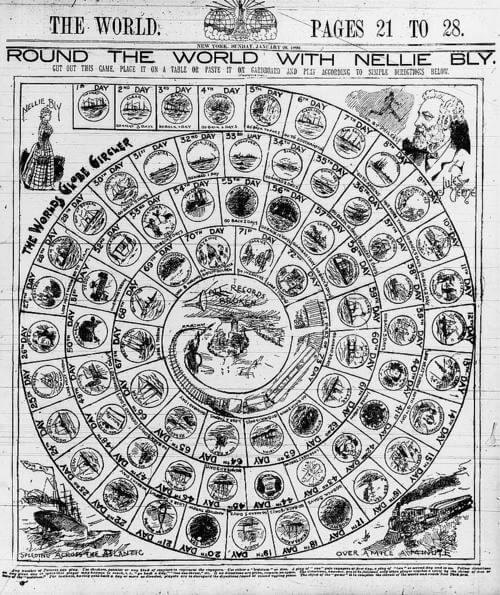
And of course, it wasn’t always easy or fair going. There is the infamous incident near the end of Elizabeth Bisland’s trip when an unknown person claiming to be a travel agent waylaid her. Do you have any favourite theories regarding what happened that made Elizabeth Bisland miss her ship?
The question of that mysterious travel agent…was he in fact paid off by Pulitzer? It’s a mystery! Nobody knows for sure. A lot of people speculated that he was, and I spent a long time trying to figure that out. I was in touch with the archivist for the Thomas Cook Travel Agency, and I got as far as being able to identify the names of the four men who worked in the Paris office. It would have been one of those four who had done it. I went through the Pulitzer letter archives to see if there was any receipt for money paid to a Thomas Cook travel official. But I never was able to get to the bottom of that. So I left it open-ended.
In terms of the role of Pulitzer and journalism: this book showcases the power of the press in America at that time, and how that has only grown. The story of the Statue of Liberty was an excellent illustrative example.
The Statue of Liberty is the perfect example of that, and a little known example.
The visual image is so striking, of her arm rising up out of Central Park.
You can go online and find a photograph of that. Pulitzer was this upstart in New York, a Jewish immigrant from Hungary who championed the rights of workers, who championed the rights of immigrants, who was not welcome at the Metropolitan Opera House among the other wealthy people of the town because of all of that. The power of the press was shown starkly in the campaign to raise money to build the base for the Statue of Liberty. Congress refused to allocate the money. For years the statue was there and there was just no place to put it. It wasn’t until Joseph Pulitzer stepped in and appealed to his readers to raise the money for this statue that it happened. In came in from these pennies and nickels from his immigrant readers. And that’s why the Statue of Liberty is out in the harbour now. It really shows the power of the press.
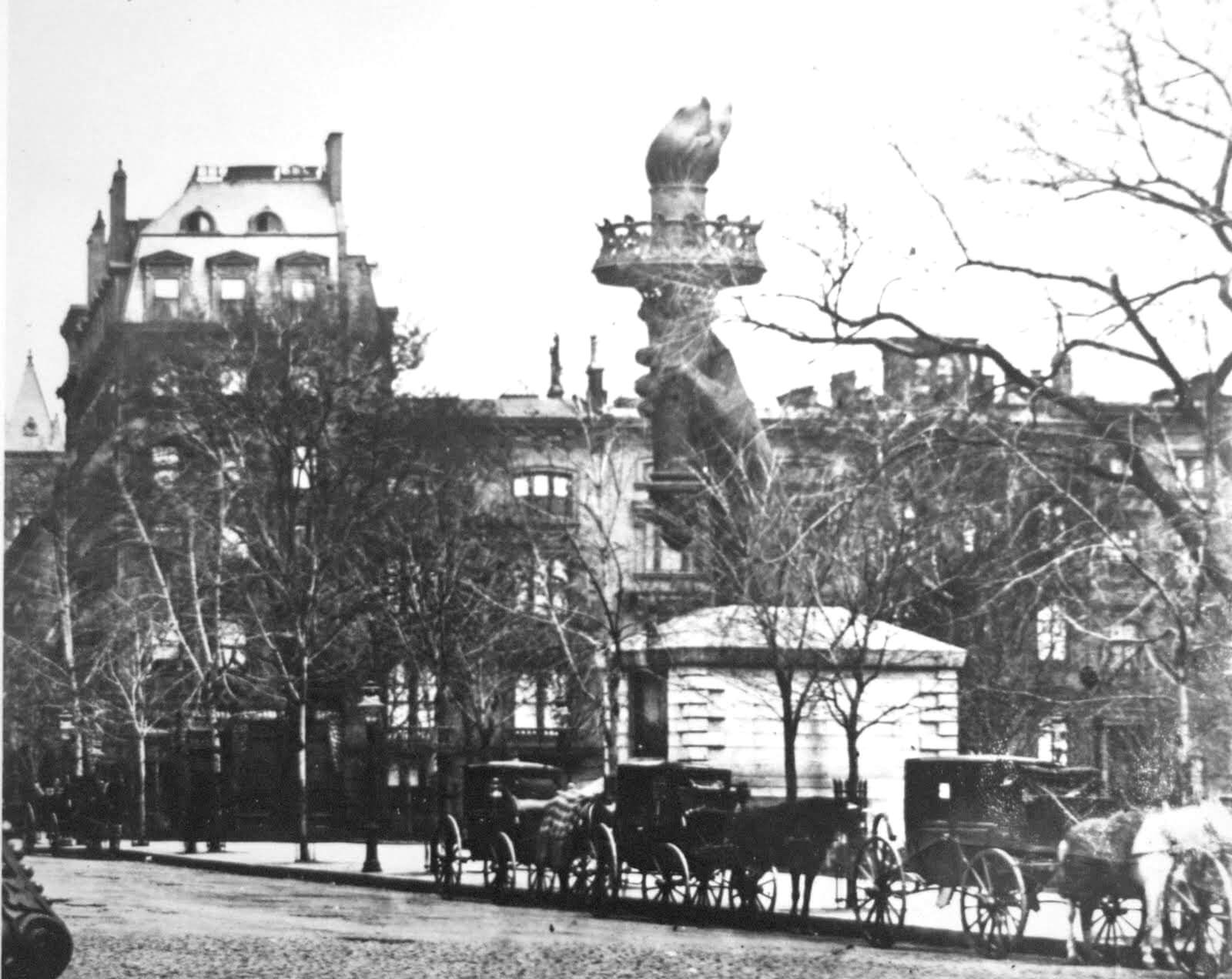
My Twitter feed is currently ablaze with talk of the Veronica Mars Kickstarter project. Basically, this movie that was never going to get made by the studios is now going to be made because fans were asked to help fund it, and they’ve already raised well over the $2 million goal. Pulitzer seems to be the original crowdfunder to me.
The world changes, but the world stays the same. A lot of the stuff that I’m talking about in the book is still true today.
Even in terms of the place of the issues faced by women in journalism, this book certainly shows what pioneers these two women were. You talk bout how women’s place was only in the society pages. I read an article earlier this month that posited that in general, when there is a bio of a renowned female author appearing in a traditional newspaper, it goes into the Style section, yet profiles of male authors always go into the Books section.
Interesting, I hadn’t read that. But I think that’s a classic case of…what is that old expression from the cigarette company? “You’ve come a long way, baby.” But not really! And there was the chart that VIDA put out about the number of women reviewers in literary magazines. It’s tiny compared to the number of male reviewers. There is still that ghettoizing of what are considered women’s topics versus men’s topics, which was really clear back then but hasn’t entirely disappeared yet.
Has there been any questioning of why you, as a male writer, are writing a book about these two strong women in history?
Happily not! It was certainly something I thought about over the course of writing it. I’ve really enjoyed seeing female reviewers saying “I love reading stories about strong female characters in history” and they don’t say “even if a man wrote it! It was a great opportunity for me as a writer to explore a different kind of character. The book I’d written before featured PT Barnum and Edgar Allan Poe. It was set in 1835 and it was all male characters. So I was definitely interested in exploring female characters of the time as well.
I understand that throughout Eighty Days, anything that appears in quotes, including dialogue, is actually quoted material taken from historical sources. Did you find that helped you get into the heads of your characters?
Yes. I was hoping that my portrayal of my interior world of these characters would be just as vivid as the exterior world through which they were racing. I wanted readers to not just know what had happened on this trip but to know what it felt like, to feel what it was like to be barrelling through the western mountains on a runaway mail train, or gliding through on a moonlit Suez Canal, or a snowshoe expedition through the Sierra Nevada mountains, blockaded by 20 feet of snow. Whatever it might be! So I was very fortunate that both women had written books about their trips, which allowed me access to their interior lives. That was a great boon for me as a writer.
In preparation for writing the book, I basically read everything both women ever wrote to get a sense of who they were, what their concerns were, what their type of writing was. I wanted their styles to come out in the point-of-view chapters My writing in the Elizabeth Bisland chapters is more lyrical, the sentences are longer, there’s more sensory description. That’s the way she was. And the writing in the Nellie Bly chapters is punchier and funnier and more anecdotal, much more focused on the particulars of the race and the schedules and publicity because that’s who she was. That’s what she was interested in. I did about 18 months of research before I even wrote the first word just because I wanted the world of the story to bloom in my mind, to be as vivid as possible to me.
Were you digging through archives and letters the whole time? Did you travel at all?
If I could have travelled to Hong Kong in the year 1889 I would have! It was certainly something I thought about. If Random House had paid for me to do an around the world trip, I would have done it! But frankly, the world I’m writing about is a vanished world. Hong Kong is entirely different now than it was in 1889. These places just aren’t there anymore. Even New York, which is probably the least changed of these cities since then. . . if you wanted to investigate what New York was like in 1889, you wouldn’t go to New York today to find that. It’s totally different.
What I discovered is that the historian is really a kind of traveller. You’re travelling to a foreign place, and that place is the past. I actually found that guidebooks were extremely helpful. I had to get guidebooks from that particular time. Hong Kong in 1910 is very different from Hong Kong in 1890. If you read a guidebook for, say, New York in 1890, it’s enormously helpful because there are walking tours in these books, and they say things like “Stand on the corner of 14th Street and Broadway and walk two blocks north and you’ll see such-and-such a building, and turn right and that’s where the famous Delmonico’s restaurant is.” You really get a sense of what these places were like! And what people ate and where they went to eat and what the hotels were like and what people wore. I read as many of the guidebooks as I possible could. I read travellers’ accounts who had been to some of these same places, travelled on some of these same ships as these two women. I read biographies of people like Pulitzer. Just read everything I possibly could to get as full a sense as I possibly could.
Writing a book like this is almost like giving yourself a university crash course on your chosen topic.
That’s right!
Have you read the original Verne, Around the World in 80 Days?
Oh yes, many times. I love it. And one of my favourite things to do was to write the scene between Jules Verne and Nellie Bly. I loved the interesting encounter they had, her awe for the great writer, the charm that he took in her. And his saying “If you do this in 79 days, I shall clap with both hands!” And her being awed to see the actual map that he had mapped out Phileas Fogg’s route for Around the World in Eighty Days. As it happens, next week there’s a theatre company in Vermont that’s doing an original production of Around the World in Eighty Days. So I’m going to go and give a talk about the book after one of their performances.
I”m curious about the role of New York in your writing. This race starts in New York, your previous work has looked at showmen and hoaxers in New York. Do you find that your city looms in your consciousness?
Absolutely. I’m a born-and-raised New Yorker. My kids are fourth-generation Brooklynites. I’m endlessly fascinated by New York, by the complexity, by the variousness, by the excitement, by the tragedy, by the showmanship, by the daring quality of the city in that it’s a home for immigrants from all over the world. The whole world lives in New York. Definitely one of the things I liked about this book is that the book does begin and end in New York, and that gave me the opportunity to talk about New York in a different time period. I just think I’ll never grown bored with New York. I don’t know what I’ll do for my next book but if takes place in New York, I’ll be delighted.
And do you have any inklings of what your next project might be?
You know what, I’ve had 15 ideas for books that have all gone by the wayside for one reason or another. The short answer is no, I don’t know what I’m going to do next. I’m searching for the next book idea. I’ve talked to other people who do what I do and we all agree that the most harrowing part of the process is trying to find the idea in the first place. To do a book like this, it’s not like you just want to write another history of World War I. You need to find a story that has a great main character or characters, that has a well-defined narrative arc, that has a lot of material available to it so you can write it in that novelistic way, but at the same time a story that hasn’t already been told before. Seabiscuit’s taken! You can’t do Seabiscuit now. Ideally, you want a story like this that allows you to explore larger issues than just the story itself. Something that has all those attributes? Those are hard to come by, and that is what I’m searching for.
Do you wait until something passes by and grabs you?
No, no, I go to the library all the time! I spend hours just searching. Like I said, I’ve had 15 ideas and I’ve dispensed with them because it turns out the idea is not really big enough for a whole book, or it turns out there isn’t enough material available on the main character, or it turns out somebody else has already done that book or is in the process of doing that book, so that’s my job. If you have any ideas, I’m delighted to hear them!
One last question: Do you have a secret favourite? Were you rooting for one lady to win the race over the other?
I knew right from the beginning who was going to win, so I wasn’t necessarily rooting for one over the other. But I was rooting for them to be as great characters as they could possibly could be. And they were! And that was wonderful. I was also rooting for them to change over the course of the trip, as they would in a novel. And they did. They did change over the course of this trip. So I was rooting for that as well. I would say the thing I am most gratified about is that I’m able to reintroduce Nellie Bly to a new generation of readers, people who might be familiar with her name but not quite know why.
And I would say I am even more gratified to introduce today’s readers to Elizabeth Bisland, because nobody knows about her. Nobody’s written a book about her. And she turns out to be a really remarkable person and a beautiful writer. I loved reading her work, her novel, her books of essays. Sh was somebody who was deeply committed to literature and to her own writing, who was writing right up to the end of her life. She wrote some of her most beautiful essays right at the end of her life, about old age and mortality. Those books are out of print. If somehow we can get them back into print as a result of this, that would be incredible. There are people now who know who Elizabeth Bisland is, was, who didn’t know before—that’s really gratifying to me.
You might also like:
|
|

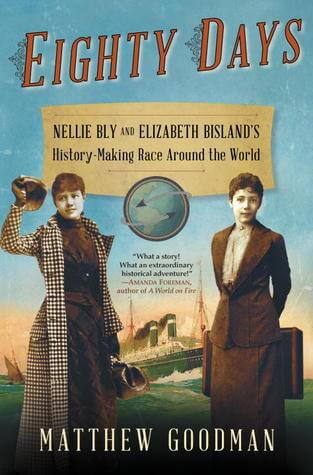
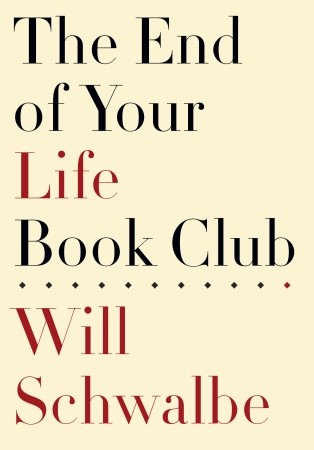
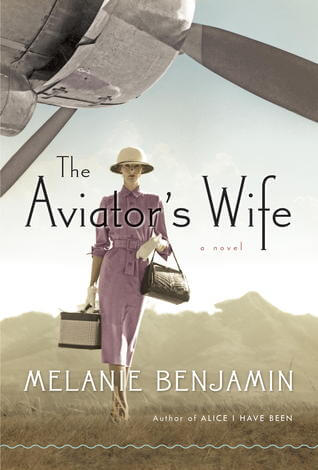
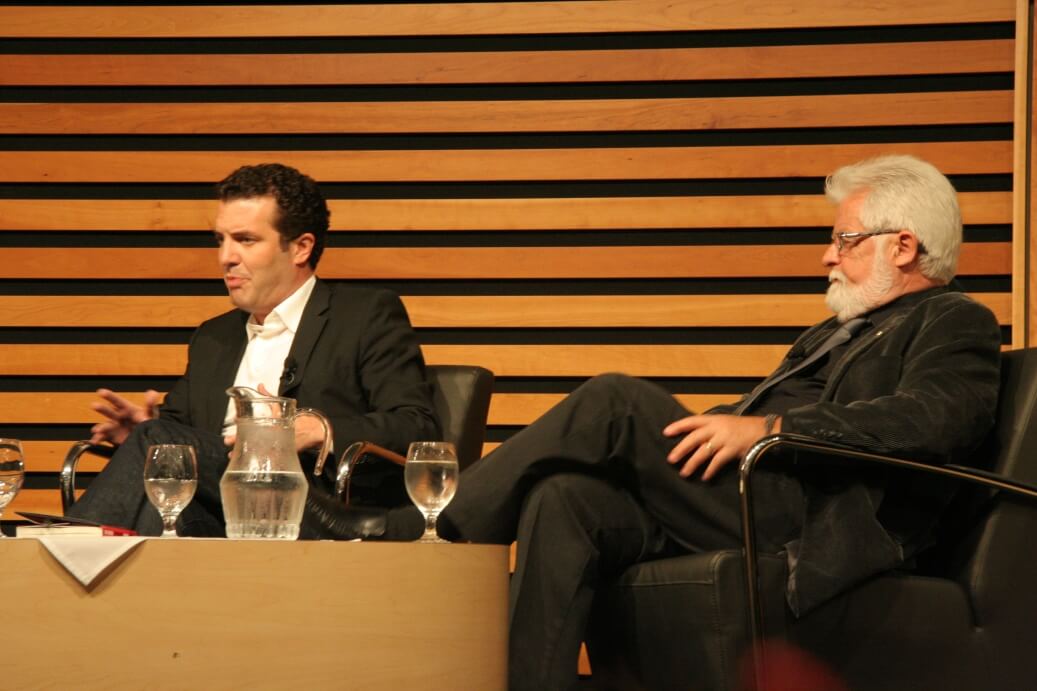
This was a really interesting interview! I’ve read the book and enjoyed it, and my nonfiction book group is discussing it tonight, so I’ll be sharing this interview with people, too. 🙂